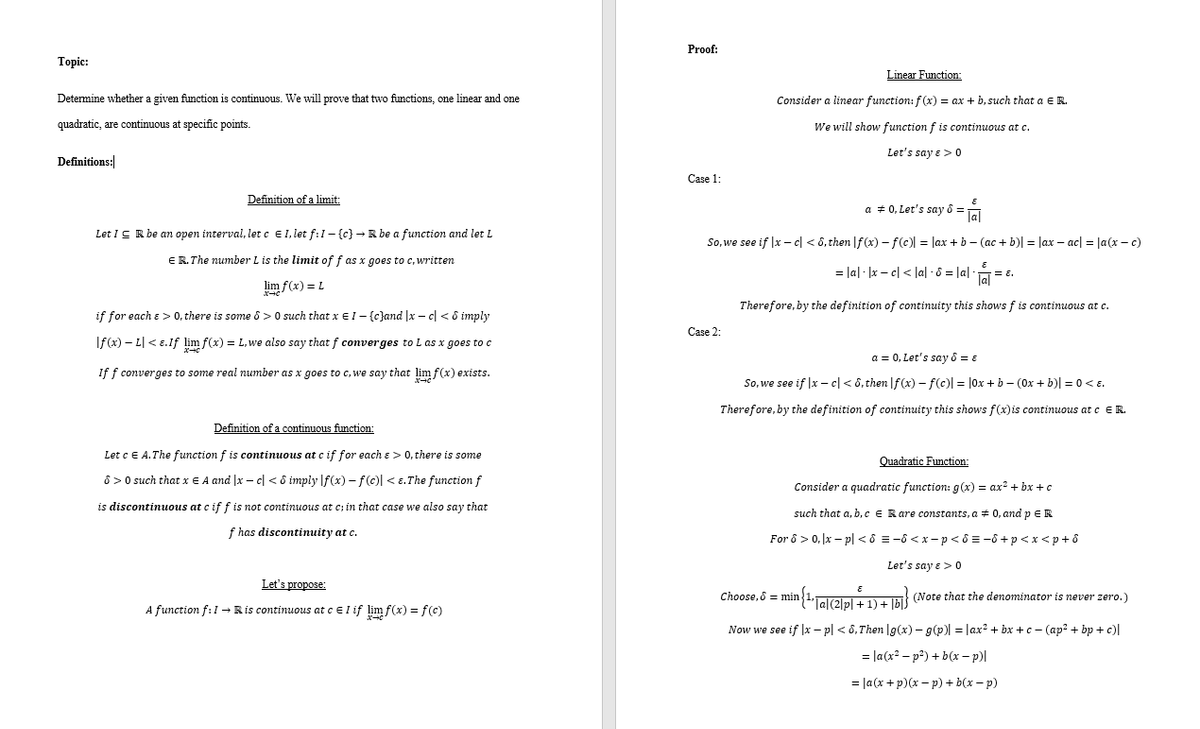My professor gave me these two questions about my proof. Please answer with plenty of details. Thanks!
1.In your linear proof, specifically the a = 0 case, you used delta = epsilon, which worked just fine. What are examples of two other choices of delta that would also have worked?
2.In your quadratic proof, is there any danger of this denominator being 0: |a|*(1 + 2|p|) + |b|? Explain.
![= |(a(x + p) + b)(x - p)|<br>= la(x – p) + blx – pl<br>< la(x + p) + b|ô<br>*< (lal - (2|pl + 1)+ |b|) -<br>= E<br>(lal - (2|p| + 1) + |b|)<br>* la(x + p) + b| <|(x – p)| + lb| by Triangle Inequality<br>= la|lx + p| + |b|<br>< lal · (1x| + \pl) + |b| by Triangle Inequality<br>= lal - (lpl +1+ |pl) + |b], Since |x| < \p] + ô<br>= Ial • (2]p| + 1) + |비 > 이<br>Therefore, by the definition of continuity this shows g(x)is continuous at p e R.<br>](https://s3.us-east-1.amazonaws.com/storage.unifolks.com/qimg-008/008_9gzrxp0-llxqqtl3.png)
Extracted text: = |(a(x + p) + b)(x - p)| = la(x – p) + blx – pl < la(x="" +="" p)="" +="" b|ô="">< (lal="" -="" (2|pl="" +="" 1)+="" |b|)="" -="E" (lal="" -="" (2|p|="" +="" 1)="" +="" |b|)="" *="" la(x="" +="" p)="" +="" b|=""><|(x –="" p)|="" +="" lb|="" by="" triangle="" inequality="la|lx" +="" p|="" +="" |b|="">< lal="" ·="" (1x|="" +="" \pl)="" +="" |b|="" by="" triangle="" inequality="lal" -="" (lpl="" +1+="" |pl)="" +="" |b],="" since="" |x|="">< \p]="" +="" ô="Ial" •="" (2]p|="" +="" 1)="" +="" |비=""> 이 Therefore, by the definition of continuity this shows g(x)is continuous at p e R.

Extracted text: Proof: Тopic: Linear Function: Determine whether a given function is continuous. We will prove that two functions, one linear and one Consider a linear function: f (x) = ax + b, such that a ER. quadratic, are continuous at specific points. We will show function f is continuous at c. Let's say e > Definitions: Сase 1: Definition of a limit: a + 0, Let's say ô = Ja Let IC R be an open interval, let c EI, let f:1- {c) - R be a function and let L So, we see if |x – cl < 6,="" then="" |f(x)="" -="" f(c)="lax" +="" b="" -="" (ac="" +="" b)|="lax" –="" ac|="|a(x" –="" c)="" er.the="" number="" l="" is="" the="" limit="" of="" f="" as="" x="" goes="" to="" c,="" written="lal" ·="" |x="" –="" c|="">< lal="" -="" 8="|a" ·="" e.="" lim="" f(x)="L" therefore,="" by="" the="" definition="" of="" continuity="" this="" shows="" f="" is="" continuous="" at="" c.="" if="" for="" each="" e=""> 0, there is some 8 > 0 such that x EI- {c}and |x - c| < ô="" imply="" case="" 2:="" if(x)="" –="" l|="">< e.if="" lim="" f(x)="L,we" also="" say="" that="" f="" converges="" to="" l="" as="" x="" goes="" to="" c="" a="0," let's="" say="" 8="ɛ" if="" f="" converges="" to="" some="" real="" number="" as="" x="" goes="" to="" c,="" we="" say="" that="" lim="" f(x)="" exists.="" so,="" we="" see="" if="" |x="" –="" cl="">< 6,="" then="" |f="" (x)="" -="" f(c)|="|0x" +="" b="" -="" (0x="" +="" b)|="0"> 0, there is some Quadratic Function: 8 > 0 such that x E A and |x – c| < 8="" imply="" |f(x)="" –="" f(c)l="">< e.="" the="" function="" f="" consider="" a="" quadratic="" function:="" g(x)="ax?" +="" bx="" +="" c="" is="" discontinuous="" at="" c="" if="" f="" is="" not="" continuous="" at="" c;="" in="" that="" case="" we="" also="" say="" that="" such="" that="" a.="" b,ce="" rare="" constants,="" a="" +="" 0,="" and="" p="" er="" f="" has="" discontinuity="" at="" c.="" for="" ô=""> 0, x – pl < ô="-8">< x="">< 8="-ô">< 6, then |g(x) – g(p)| = lax? + bx +c - (ap? + bp + c)| = la(x? – p2) + b(x – p)| = la(x +p)(x – p) + b(x – p) 6,="" then="" |g(x)="" –="" g(p)|="lax?" +="" bx="" +c="" -="" (ap?="" +="" bp="" +="" c)|="la(x?" –="" p2)="" +="" b(x="" –="" p)|="la(x" +p)(x="" –="" p)="" +="" b(x="" –="">